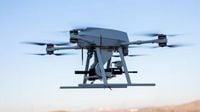On the night of May 8, 2025, Pakistan launched a significant military operation against India, deploying between 300 to 400 Turkish-made Asisguard Songar drones to target various military and civilian installations along the western border. However, the operation was met with swift and effective resistance from Indian aerial defense systems, which successfully neutralized all incoming threats before they could inflict any damage.
According to a briefing from India's Ministry of External Affairs (MEA) on May 9, the Songar drones were intended to infiltrate 36 locations across India. Colonel Sofiya Qureshi, who addressed the media, confirmed that forensic investigations into the wreckage of the drones indicated they were Turkish-made Asisguard Songar models. "The Pakistani army violated Indian airspace several times over the entire western border with the intention of targeting military infrastructure," she stated. "Around 300 to 400 drones were used to attempt infiltration at 36 locations."
The Songar drone, developed by Asisguard, a Turkish defense technology company based in Ankara, is notable for being Turkey's first domestically produced armed drone system. It entered service with the Turkish Armed Forces (TAF) in early 2020 and has been adapted for various weapon systems, including a 5.56×45mm NATO machine gun capable of carrying 200 rounds, a 7.62×39mm infantry rifle, and a six-barrel 40mm grenade launcher.
Equipped with advanced technology, the Songar drone can operate autonomously or be controlled remotely. It features real-time video transmission capabilities and can fly at altitudes of up to 2,800 meters. Its operational range extends up to 10 kilometers, and it is designed for both day and night operations, making it a versatile asset for military and security forces.
Despite its advanced features, the Songar drone proved ineffective against India's layered aerial defense systems, which include the Akash and S-400 systems. Reports indicate that Indian forces successfully intercepted the majority of the drones before they could reach their intended targets. Colonel Qureshi noted, "We brought down these drones using both kinetic and non-kinetic means. The likely objective was to test our air defense systems and gather intelligence."
In a retaliatory move, India targeted four air defense sites in Pakistan, successfully hitting one air defense radar. This exchange underscores the escalating tensions between the two nations, particularly in light of recent military operations. Just a day prior to the drone strike, India had launched Operation Sindoor, targeting terror cells across Pakistan and Pakistan-occupied Kashmir.
The use of Songar drones by Pakistan is indicative of the growing defense ties between Islamabad and Ankara. Turkish President Recep Tayyip Erdoğan has expressed support for Pakistan's military actions, emphasizing the importance of their bilateral relationship. Following the drone attacks, Erdoğan backed Pakistan's proposal for an international investigation into the recent violence, calling it "appropriate" and "valuable." He also extended condolences to the people of Pakistan for their losses in the ongoing conflict.
In a broader context, the deployment of the Songar drones represents a significant shift in the dynamics of drone warfare in South Asia. The combination of firepower, autonomy, and swarm tactics makes the Songar a formidable tool for modern military operations. Its capabilities allow for coordinated attacks, overwhelming enemy defenses and complicating the response strategies of adversaries.
On the operational front, the Songar drone's modular design allows for integration with various weapon systems, enhancing its combat effectiveness. It can be equipped not only with machine guns but also with grenade launchers and mini-missile systems, broadening its tactical applications on the battlefield.
Despite the effectiveness of the Songar drones in theory, the recent events highlight the challenges Pakistan faces in executing successful drone operations against a technologically advanced adversary like India. The failure to inflict damage during this operation raises questions about the strategic planning and execution of such military initiatives.
As the situation continues to evolve, the implications of this drone strike will likely reverberate through diplomatic channels. Both nations are expected to reassess their military strategies in light of the recent developments, particularly as they pertain to aerial defense and counter-drone technologies.
In conclusion, the May 8 drone attack marks a notable episode in the ongoing India-Pakistan conflict, showcasing the complexities of modern warfare and the critical role of technology in shaping military engagements. As both nations navigate these tensions, the international community watches closely, aware that any miscalculation could lead to further escalation.



